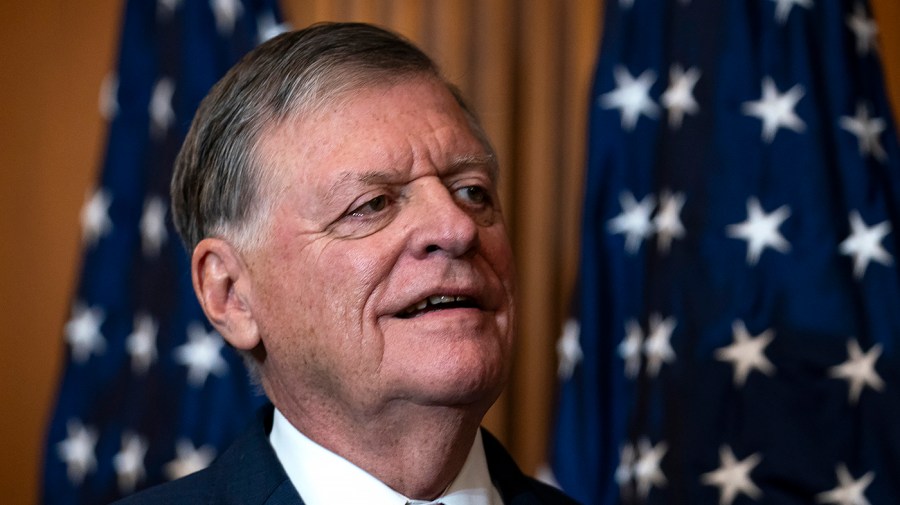Congress is struggling to strike a deal to keep the government funded as a looming deadline to prevent a shutdown next month gets closer.
Lawmakers are less than a month away from a mid-March date to pass legislation to prevent a funding lapse — or risk the first shutdown in years.
“We can’t have precisely the same kind of deal we had before, and we’re trying to work to find some common ground,” House Appropriations Committee Chair Tom Cole (R-Okla.) said shortly before the House left for a one-week recess this week.
Negotiators on both sides have been working to strike a spending deal for weeks, with hopes of crafting the 12 annual funding bills that could make it out of both chambers with bipartisan support — and across President Trump’s desk for signature.
But they also say the task has gotten more difficult as fallout spreads over a sweeping operation undertaken by the Trump administration to reshape the federal government.
“We cannot come to a deal where you hammer out gains, losses, but you come to a conclusion and you come to a meeting of the minds,” Rep. Rosa DeLauro (Conn.), the top Democrat on the House Appropriations Committee, told reporters. “That should not be subject to some third party deciding that that’s not what they want.”
“We had a deal last year, all of us and so forth, and then there was an interloper with no authority, no legitimacy, nonelected, who said, ‘Don’t vote for it,’” DeLauro said, as Democrats have continued to zero in on tech billionaire Elon Musk, the head of Trump’s Department of Government Efficiency (DOGE).
DeLauro and Cole have both continued to press for a deal on a top-line agreement on how much to fund the government for fiscal 2025 — a key step to kick off work on hashing out annual funding bills. But there is growing acknowledgement that a stopgap of some kind is necessary as Congress hurtles toward a March 14 deadline to keep the lights on with no clear plan on how to prevent a funding lapse.
Speaker Mike Johnson (R-La.) has left the door open to the idea of a stopgap, also known as a continuing resolution (CR), that would run through the end of the fiscal year. The idea has some support from conservatives who want to see funding levels kept flat through September, even if it locks in continued spending in line with some of former President Biden’s funding priorities in the meantime. However, some Republicans are resisting the idea.
House Armed Services Committee Chair Mike Rogers (R-Ala.) told The Hill last week that he thinks a “full-year CR is just a knuckleheaded approach,” adding he wouldn’t back the idea “unless it holds defense harmless.”
“It would have to be like we passed an appropriations bill for defense,” he said when asked by reporters what kind of changes would be necessary for him to support a stopgap through the end of the fiscal year.
“I don’t like full-year CRs,” Rep. Steve Womack (R-Ark.), a spending cardinal, also said plainly last week when asked about the prospect of such an idea, though he added that he didn’t know if the proposal is more likely as Congress continues to run months behind in tying up its funding work.
“We’ll see. We need to do our work,” he said.
Some Republicans have ambitious hopes of resorting to a wonky procedure known as “budget reconciliation” to pass a partisan funding package that would boost dollars in areas like border and defense ahead of the mid-March deadline. The measure would allow Republicans to bypass a 60-vote threshold needed for most bills to pass the Senate, allowing them to get past likely Democratic opposition.
“It’d be really helpful if we had $150 billion of new money before March 14, because the discussions about funding the government are dramatically different,” Senate Budget Committee Chair Lindsey Graham (R-S.C.) told The Hill last week, as he pushes his GOP colleagues in the House and Senate to get behind the strategy to advance parts of Trump’s agenda.
Adding to complications, however, House Republicans are still pushing to take the lead on a reconciliation package that would also plus up border and defense funds, but would additionally greenlight trillions of dollars in tax cuts and significant spending cuts.
Congress is also staring down the threat of automatic cuts to federal programs after April 30 under a previous agreement struck between GOP leadership and Biden in 2023 to raise the debt ceiling.
Cole has said lawmakers should be able to avoid triggering those cuts in the event Congress passes a full-year stopgap, though appropriators are still holding out for full-year funding bills.
“It’s a month away,” Rep. Mark Amodei (R-Nev.), head of the subcommittee that oversees funding for the Department of Homeland Security, told The Hill. “We’re the guys who passed s‑‑‑ the day before. Joe Biden was signing stuff at midnight.”
“My understanding was that Patty Murray, Rosa DeLauro and Tom Cole were about $14 billion apart,” he added, when discussing the state of top-line discussions last week. “That’s a hell of a lot of money, but in the context of the overall budget, that’s kind of big dust particles.”
